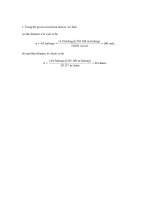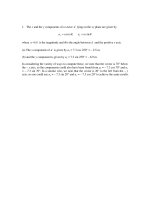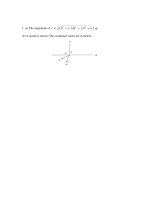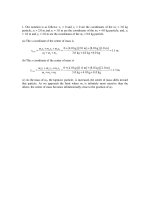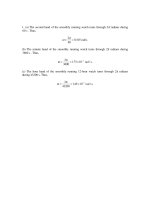Solution manual fundamentals of physics extended, 8th editionch08
Bạn đang xem bản rút gọn của tài liệu. Xem và tải ngay bản đầy đủ của tài liệu tại đây (1.28 MB, 144 trang )
1. The potential energy stored by the spring is given by U = 21 kx 2 , where k is the spring
constant and x is the displacement of the end of the spring from its position when the
spring is in equilibrium. Thus
k=
b g
b
g
2 25 J
2U
=
2
x
0.075 m
2
= 8.9 × 103 N m .
2. (a) NotingG that the vertical displacement is 10.0 – 1.5 = 8.5 m downward (same
direction as Fg ), Eq. 7-12 yields
Wg = mgd cos φ = ( 2.00) ( 9.8) (8.5) cos 0° = 167 J.
(b) One approach (which is fairly trivial) is to use Eq. 8-1, but we feel it is instructive to
instead calculate this as ∆U where U = mgy (with upwards understood to be the +y
direction).
∆U = mgy f − mgyi = (2.00) (9.8) (15
. ) − (2.00) (9.8) (10.0) = −167 J.
(c) In part (b) we used the fact that Ui = mgyi =196 J.
(d) In part (b), we also used the fact Uf = mgyf = 29 J.
(e) The computation of Wg does not use the new information (that U = 100 J at the
ground), so we again obtain Wg = 167 J.
(f) As a result of Eq. 8-1, we must again find ∆U = –Wg = –167 J.
(g) With this new information (that U0 = 100 J where y = 0) we have
Ui = mgyi + U0 = 296 J.
(h) With this new information (that U0 = 100 J where y = 0) we have
Uf = mgyf + U0 = 129 J.
We can check part (f) by subtracting the new Ui from this result.
G G
3. (a) The force of gravity is constant, so the work it does is given by W = F ⋅ d , where
G
G
F is the force and d is the displacement. The force is vertically downward and has
magnitude mg, where m is the mass of the flake, so this reduces to W = mgh, where h is
the height from which the flake falls. This is equal to the radius r of the bowl. Thus
W = mgr = (2.00 × 10−3 kg) (9.8 m s2 ) (22.0 × 10−2 m) = 4.31 × 10−3 J.
(b) The force of gravity is conservative, so the change in gravitational potential energy of
the flake-Earth system is the negative of the work done: ∆U = –W = –4.31 × 10–3 J.
(c) The potential energy when the flake is at the top is greater than when it is at the
bottom by |∆U|. If U = 0 at the bottom, then U = +4.31 × 10–3 J at the top.
(d) If U = 0 at the top, then U = – 4.31 × 10–3 J at the bottom.
(e) All the answers are proportional to the mass of the flake. If the mass is doubled, all
answers are doubled.
4. (a) The only force that does work on the ball is the force of gravity; the force of the rod
is perpendicular to the path of the ball and so does no work. In going from its initial
position to the lowest point on its path, the ball moves vertically through a distance equal
to the length L of the rod, so the work done by the force of gravity is
W = mgL = (0.341 kg)(9.80 m/s 2 )(0.452 m) = 1.51 J .
(b) In going from its initial position to the highest point on its path, the ball moves
vertically through a distance equal to L, but this time the displacement is upward,
opposite the direction of the force of gravity. The work done by the force of gravity is
W = − mgL = −(0.341 kg)(9.80 m/s 2 )(0.452 m) = − 1.51 J
(c) The final position of the ball is at the same height as its initial position. The
displacement is horizontal, perpendicular to the force of gravity. The force of gravity
does no work during this displacement.
(d) The force of gravity is conservative. The change in the gravitational potential energy
of the ball-Earth system is the negative of the work done by gravity:
∆ U = − mgL = −(0.341 kg)(9.80 m/s 2 )(0.452 m) = − 1.51 J
as the ball goes to the lowest point.
(e) Continuing this line of reasoning, we find
∆ U = + mgL = (0.341 kg)(9.80 m/s 2 )(0.452 m) = 1.51 J
as it goes to the highest point.
(f) Continuing this line of reasoning, we have ∆U = 0 as it goes to the point at the same
height.
(g) The change in the gravitational potential energy depends only on the initial and final
positions of the ball, not on its speed anywhere. The change in the potential energy is the
same since the initial and final positions are the same.
5. We use Eq. 7-12 for Wg and Eq. 8-9 for U.
(a) The displacement between the initial point and A is horizontal, so φ = 90.0° and
Wg = 0 (since cos 90.0° = 0).
(b) The displacement between Gthe initial point and B has a vertical component of h/2
downward (same direction as Fg ), so we obtain
G G 1
1
Wg = Fg ⋅ d = mgh = (825 kg)(9.80 m/s 2 )(42.0 m) = 1.70 × 105 J .
2
2
(c) The displacement betweenG the initial point and C has a vertical component of h
downward (same direction as Fg ), so we obtain
G G
Wg = Fg ⋅ d = mgh = (825 kg)(9.80 m/s 2 )(42.0 m) = 3.40 ×105 J .
(d) With the reference position at C, we obtain
UB =
1
1
mgh = (825 kg)(9.80 m/s 2 )(42.0 m) = 1.70 × 105 J
2
2
(e) Similarly, we find
U A = mgh = (825 kg)(9.80 m/s 2 )(42.0 m) = 3.40 ×105 J
(f) All the answers are proportional to the mass of the object. If the mass is doubled, all
answers are doubled.
G G
6. (a) The force of gravity is constant, so the work it does is given by W = F ⋅ d , where
G
G
F is the force and d is the displacement. The force is vertically downward and has
magnitude mg, where m is the mass of the snowball. The expression for the work reduces
to W = mgh, where h is the height through which the snowball drops. Thus
W = mgh = (1.50 kg)(9.80 m/s 2 )(12.5 m) = 184 J .
(b) The force of gravity is conservative, so the change in the potential energy of the
snowball-Earth system is the negative of the work it does: ∆U = –W = –184 J.
(c) The potential energy when it reaches the ground is less than the potential energy when
it is fired by |∆U|, so U = –184 J when the snowball hits the ground.
7. We use Eq. 7-12 for Wg and Eq. 8-9 for U.
(a) The displacement between the
G initial point and Q has a vertical component of h – R
downward (same direction as Fg ), so (with h = 5R) we obtain
G G
Wg = Fg ⋅ d = 4mgR = 4(3.20 × 10− 2 kg)(9.80 m/s 2 )(0.12 m) = 0.15 J .
(b) The displacement between the initial point andG the top of the loop has a vertical
component of h – 2R downward (same direction as Fg ), so (with h = 5R) we obtain
G G
Wg = Fg ⋅ d = 3mgR = 3(3.20 ×10− 2 kg)(9.80 m/s 2 )(0.12 m) = 0.11 J .
(c) With y = h = 5R, at P we find
U = 5mgR = 5(3.20 ×10− 2 kg)(9.80 m/s 2 )(0.12 m) = 0.19 J .
(d) With y = R, at Q we have
U = mgR = (3.20 × 10− 2 kg)(9.80 m/s 2 )(0.12 m) = 0.038 J
(e) With y = 2R, at the top of the loop, we find
U = 2mgR = 2(3.20 × 10− 2 kg)(9.80 m/s 2 )(0.12 m) = 0.075 J
(f) The new information (vi ≠ 0) is not involved in any of the preceding computations;
the above results are unchanged.
8. The main challenge for students in this type of problem seems to be working out the
trigonometry in order to obtain the height of the ball (relative to the low point of the
swing) h = L – L cos θ (for angle θ measured from vertical as shown in Fig. 8-29). Once
this relation (which we will not derive here since we have found this to be most easily
illustrated at the blackboard) is established, then the principal results of this problem
follow from Eq. 7-12 (for Wg ) and Eq. 8-9 (for U ).
(a) The vertical component of the displacement vector is downward with magnitude h, so
we obtain
G G
Wg = Fg ⋅ d = mgh = mgL(1 − cos θ )
= (5.00 kg)(9.80 m/s 2 )(2.00 m)(1 − cos 30°) = 13.1 J
(b) From Eq. 8-1, we have ∆U = –Wg = –mgL(1 – cos θ ) = –13.1 J.
(c) With y = h, Eq. 8-9 yields U = mgL(1 – cos θ ) = 13.1 J.
(d) As the angle increases, we intuitively see that the height h increases (and, less
obviously, from the mathematics, we see that cos θ decreases so that 1 – cos θ increases),
so the answers to parts (a) and (c) increase, and the absolute value of the answer to part (b)
also increases.
9. (a) If Ki is the kinetic energy of the flake at the edge of the bowl, Kf is its kinetic
energy at the bottom, Ui is the gravitational potential energy of the flake-Earth system
with the flake at the top, and Uf is the gravitational potential energy with it at the bottom,
then Kf + Uf = Ki + Ui.
Taking the potential energy to be zero at the bottom of the bowl, then the potential energy
at the top is Ui = mgr where r = 0.220 m is the radius of the bowl and m is the mass of the
flake. Ki = 0 since the flake starts from rest. Since the problem asks for the speed at the
1
bottom, we write mv 2 for Kf. Energy conservation leads to
2
G G
W g = Fg ⋅ d = mgh = mgL (1 − cos θ ) .
The speed is v = 2 gr = 2.08 m/s .
(b) Since the expression for speed does not contain the mass of the flake, the speed would
be the same, 2.08 m/s, regardless of the mass of the flake.
(c) The final kinetic energy is given by Kf = Ki + Ui – Uf. Since Ki is greater than before,
Kf is greater. This means the final speed of the flake is greater.
10. We use Eq. 8-17, representing the conservation of mechanical energy (which neglects
friction and other dissipative effects).
(a) In the solution to exercise 2 (to which this problem refers), we found Ui = mgyi = 196J
and Uf = mgyf = 29.0 J (assuming the reference position is at the ground). Since Ki = 0
in this case, we have
0 + 196 = K f + 29.0
which gives Kf
= 167 J and thus leads to
v=
2K f
m
=
2(167)
= 12.9 m s.
2.00
(b) If we proceed algebraically through the calculation in part (a), we find Kf = – ∆U =
mgh where h = yi – yf and is positive-valued. Thus,
v=
2K f
m
= 2 gh
as we might also have derived from the equations of Table 2-1 (particularly Eq. 2-16).
The fact that the answer is independent of mass means that the answer to part (b) is
identical to that of part (a), i.e., v = 12.9 m/s .
(c) If Ki ≠ 0 , then we find Kf = mgh + Ki (where Ki is necessarily positive-valued). This
represents a larger value for Kf than in the previous parts, and thus leads to a larger value
for v.
11. We use Eq. 8-17, representing the conservation of mechanical energy (which neglects
friction and other dissipative effects).
(a) In Problem 4, we found UA = mgh (with the reference position at C). Referring again
to Fig. 8-32, we see that this is the same as U0 which implies that KA = K0 and thus that
vA = v0 = 17.0 m/s.
(b) In the solution to Problem 4, we also found U B = mgh 2. In this case, we have
K0 + U 0 = K B + U B
FG IJ
HK
1 2
1
h
mv0 + mgh = mv B2 + mg
2
2
2
which leads to
vB = v02 + gh = (17.0)2 + (9.80)(42.0) = 26.5 m/s.
(c) Similarly,.
vC = v02 + 2 gh = (17.0) 2 + 2(9.80)(42.0) = 33.4 m/s.
(d) To find the “final” height, we set Kf = 0. In this case, we have
K0 + U 0 = K f + U f
1 2
mv0 + mgh = 0 + mgh f
2
v02
(17.0 m/s)2
which leads to h f = h +
= 42.0 m +
= 56.7 m.
2g
2(9.80 m/s 2 )
(e) It is evident that the above results do not depend on mass. Thus, a different mass for
the coaster must lead to the same results.
12. We use Eq. 8-18, representing the conservation of mechanical energy (which neglects
friction and other dissipative effects).
(a) In the solution to Problem 4 we found ∆U = mgL as it goes to the highest point. Thus,
we have
∆K + ∆U = 0
Ktop − K0 + mgL = 0
which, upon requiring Ktop = 0, gives K0 = mgL and thus leads to
v0 =
2K0
= 2 gL = 2(9.80 m/s 2 )(0.452 m) = 2.98 m/s .
m
(b) We also found in the Problem 4 that the potential energy change is ∆U = –mgL in
going from the initial point to the lowest point (the bottom). Thus,
∆K + ∆U = 0
Kbottom − K0 − mgL = 0
which, with K0 = mgL, leads to Kbottom = 2mgL. Therefore,
vbottom =
2 K bottom
= 4 gL = 4(9.80 m/s 2 )(0.452 m) = 4.21 m/s .
m
(c) Since there is no change in height (going from initial point to the rightmost point),
then ∆U = 0, which implies ∆K = 0. Consequently, the speed is the same as what it was
initially,
vright = v0 = 2.98 m/s .
(d) It is evident from the above manipulations that the results do not depend on mass.
Thus, a different mass for the ball must lead to the same results.
13. We neglect any work done by friction. We work with SI units, so the speed is
converted: v = 130(1000/3600) = 36.1 m/s.
(a) We use Eq. 8-17: Kf + Uf = Ki + Ui with Ui = 0, Uf = mgh and Kf = 0. Since
Ki = 21 mv 2 , where v is the initial speed of the truck, we obtain
v2
.2
1
361
2
mv = mgh h =
=
= 66.5 m.
2
2 g 2(9.8)
If L is the length of the ramp, then L sin 15° = 66.5 m so that L = 66.5/sin 15° = 257 m.
Therefore, the ramp must be about 2.6 × 102 m long if friction is negligible.
(b) The answers do not depend on the mass of the truck. They remain the same if the
mass is reduced.
(c) If the speed is decreased, h and L both decrease (note that h is proportional to the
square of the speed and that L is proportional to h).
14. We use Eq. 8-18, representing the conservation of mechanical energy. We choose the
reference position for computing U to be at the ground below the cliff; it is also regarded
as the “final” position in our calculations.
(a) Using Eq. 8-9, the initial potential energy is given by Ui = mgh where h = 12.5 m and
m = 1.50 kg . Thus, we have
Ki + U i = K f + U f
1 2
1
mvi + mgh = mv 2 + 0
2
2
which leads to the speed of the snowball at the instant before striking the ground:
v=
FG
H
IJ
K
2 1 2
mvi + mgh = vi2 + 2 gh
m 2
where vi = 14.0 m/s is the magnitude of its initial velocity (not just one component of it).
Thus we find v = 21.0 m/s.
(b) As noted above, vi is the magnitude of its initial velocity and not just one component
of it; therefore, there is no dependence on launch angle. The answer is again 21.0 m/s.
(c) It is evident that the result for v in part (a) does not depend on mass. Thus, changing
the mass of the snowball does not change the result for v.
15. We make use of Eq. 8-20 which expresses the principle of energy conservation:
∆ K + ∆ U g + ∆ U rope = 0 .
The change in the potential energy is ∆ U g = − mg (2 H + d ) , since the leader falls a total
distance 2H+d, where d is the distance during the stretching. The change in the elastic
potential energy is ∆ U rope = kd 2 / 2 , where k is the spring constant. At the lowest
position, the leader is momentarily at rest, so that ∆ K = 0 . The above equation leads to
1 2
kd max − mgd max − 2mgH = 0
2
which can be solved to yield
d max
mg + (mg ) 2 + 4kmgH
=
.
k
In the above, only the positive root is chosen. The mass of the leader is m = 80 kg and
the spring constant is k = erope / L , where erope = 20 kN is the elasticity and L is the
length of the rope.
(a) In this situation, we have H = 3.0 m and L = (10+3.0)=13 m. The maximum distance
stretched is
d max =
mg + (mg ) 2 + 4erope mgH / L
erope / L
=
.
(80)(9.8) + (80) (9.8) + 4(2.0 × 10 )(80)(9.8)(3.0) /(13)
= 3.0 m
(2.0 × 104 ) /13
2
2
4
(b) In this situation, we have H =1.0 m and L =(1.0 +2.0) m = 3.0 m. The result is
d max =
(80)(9.8) + (80)2 (9.8) 2 + 4(2.0 × 104 )(80)(9.8)(1.0) /(3.0)
= 0.81 m
(2.0 × 104 ) / 3.0
(c) At the instant when the rope begins to stretch, for Fig. 8-9a, we have
1
mv 2 = mg (2 H ) v = 2 gH = 2 (9.8)(3.0) = 11 m/s.
2
(d) Similarly, for the situation described in Fig. 8-9c, we have
v = 2 gH = 2 (9.8)(1.0) = 6.3 m/s.
(e) The kinetic energy as a function of d is given by
1
∆ K = mg (2 H + d ) − kd 2 .
2
The dependence of ∆K on d is shown in the figure below.
∆K
4900
4850
4800
4750
0.2
0.4
0.6
0.8
1
d
(f) At the maximum speed, ∆K is also a maximum. This can be located by differentiating
the above expression with respect to d:
d (∆ K )
mg
= mg − kd = 0 d =
= 0.51 m.
d (d )
k
16. We place the reference position for evaluating gravitational potential energy at the
relaxed position of the spring. We use x for the spring's compression, measured positively
downwards (so x > 0 means it is compressed).
1
(a) With x = 0.190 m, Eq. 7-26 gives Ws = − kx 2 = −7.22 J ≈ −7.2 J for the work done
2
by the spring force. Using Newton's third law, we see that the work done on the spring is
7.2 J.
(b) As noted above, Ws = –7.2 J.
(c) Energy conservation leads to
Ki + U i = K f + U f
mgh0 = − mgx +
1 2
kx
2
which (with m = 0.70 kg) yields h0 = 0.86 m.
(d) With a new value for the height h0′ = 2h0 = 1.72 m , we solve for a new value of x
using the quadratic formula (taking its positive root so that x > 0).
mg +
1
mgh0′ = − mgx + kx 2 x =
2
which yields x = 0.26 m.
bmgg + 2mgkh′
2
0
k
17. We take the reference point for gravitational potential energy at the position of the
marble when the spring is compressed.
(a) The gravitational potential energy when the marble is at the top of its motion is
U g = mgh , where h = 20 m is the height of the highest point. Thus,
c
hd
ib
g
U g = 5.0 × 10−3 kg 9.8 m s2 20 m = 0.98 J.
(b) Since the kinetic energy is zero at the release point and at the highest point, then
conservation of mechanical energy implies ∆Ug + ∆Us = 0, where ∆Us is the change in
the spring's elastic potential energy. Therefore, ∆Us = –∆Ug = –0.98 J.
(c) We take the spring potential energy to be zero when the spring is relaxed. Then, our
result in the previous part implies that its initial potential energy is Us = 0.98 J. This must
be 21 kx 2 , where k is the spring constant and x is the initial compression. Consequently,
k=
2U s
2(0.98 J )
. × 102 N m = 31
. N cm.
=
= 31
2
(0.080 m) 2
x
18. We denote m as the mass of the block, h = 0.40 m as the height from which it dropped
(measured from the relaxed position of the spring), and x the compression of the spring
(measured downward so that it yields a positive value). Our reference point for the
gravitational potential energy is the initial position of the block. The block drops a total
distance h + x, and the final gravitational potential energy is –mg(h + x). The spring
potential energy is 21 kx 2 in the final situation, and the kinetic energy is zero both at the
beginning and end. Since energy is conserved
Ki + U i = K f + U f
0 = − mg (h + x ) +
1 2
kx
2
which is a second degree equation in x. Using the quadratic formula, its solution is
x=
mg ±
bmgg + 2mghk .
2
k
Now mg = 19.6 N, h = 0.40 m, and k = 1960 N m , and we choose the positive root so
that x > 0.
x=
b gb gb g = 0.10 m .
19.6 + 19.62 + 2 19.6 0.40 1960
1960
19. (a) With energy in Joules and length in meters, we have
bg bg
∆U = U x − U 0 = −
zb
x
0
g
6 x ′ − 12 dx ′ .
Therefore, with U (0) = 27 J, we obtain U(x) (written simply as U) by integrating and
rearranging:
U = 27 + 12 x − 3x 2 .
(b) We can maximize the above function by working through the dU
dx = 0 condition, or
we can treat this as a force equilibrium situation — which is the approach we show.
F = 0 6 xeq − 12 = 0
Thus, xeq = 2.0 m, and the above expression for the potential energy becomes U = 39 J.
(c) Using the quadratic formula or using the polynomial solver on an appropriate
calculator, we find the negative value of x for which U = 0 to be x = –1.6 m.
(d) Similarly, we find the positive value of x for which U = 0 to be x = 5.6 m
20. We use Eq. 8-18, representing the conservation of mechanical energy. The reference
position for computing U is the lowest point of the swing; it is also regarded as the
“final” position in our calculations.
(a) In the solution to problem 8, we found U = mgL(1 – cos θ ) at the position shown in
Fig. 8-34 (which we consider to be the initial position). Thus, we have
Ki + U i = K f + U f
0 + mgL(1 − cosθ ) =
1 2
mv + 0
2
which leads to
v=
2mgL(1 − cosθ )
= 2 gL(1 − cosθ ).
m
Plugging in L = 2.00 m and θ = 30.0° we find v = 2.29 m/s.
(b) It is evident that the result for v does not depend on mass. Thus, a different mass for
the ball must not change the result.
21. (a) At Q the block (which is in circular motion at that point) experiences a centripetal
acceleration v2/R leftward. We find v2 from energy conservation:
K P + U P = KQ + U Q
0 + mgh =
1 2
mv + mgR
2
Using the fact that h = 5R, we find mv2 = 8mgR. Thus, the horizontal component of the
net force on the block at Q is
F = mv2/R = 8mg=8(0.032 kg)(9.8 m/s2)= 2.5 N.
G
and points left (in the same direction as a ).
(b) The downward component of the net force on the block at Q is the downward force of
gravity
F = mg =(0.032 kg)(9.8 m/s2)= 0.31 N.
(c) To barely make the top of the loop, the centripetal force there must equal the force of
gravity:
mvt2
= mg mvt2 = mgR
R
This requires a different value of h than was used above.
K P + U P = Kt + U t
1 2
mvt + mght
2
1
mgh = (mgR) + mg (2 R)
2
0 + mgh =
Consequently, h = 2.5R = (2.5)(0.12 m) = 0.3 m.
gR (which are the only
(d) The normal force FN, for speeds vt greater than
possibilities for non-zero FN — see the solution in the previous part), obeys
FN =
mvt2
− mg
R
from Newton's second law. Since vt2 is related to h by energy conservation
K P + U P = Kt + U t gh =
1 2
vt + 2 gR
2
then the normal force, as a function for h (so long as h ≥ 2.5R — see solution in previous
part), becomes
FN =
2mgh
− 5mg
R
Thus, the graph for h ≥ 2.5R consists of a straight line of positive slope 2mg/R (which can
be set to some convenient values for graphing purposes).
FN
2
1.5
1
0.5
h
0.1
0.2
0.3
0.4
Note that for h ≤ 2.5R, the normal force is zero.
0.5
0.6
0.7
22. (a) To find out whether or not the vine breaks, it is sufficient to examine it at the
moment Tarzan swings through the lowest point, which is when the vine — if it didn't
break — would have the greatest tension. Choosing upward positive, Newton's second
law leads to
T − mg = m
v2
r
where r = 18.0 m and m = W g = 688 9.8 = 70.2 kg . We find the v2 from energy
conservation (where the reference position for the potential energy is at the lowest point).
mgh =
1 2
mv v 2 = 2 gh
2
where h = 3.20 m. Combining these results, we have
T = mg + m
FG
H
2 gh
2h
= mg 1 +
r
r
IJ
K
which yields 933 N. Thus, the vine does not break.
(b) Rounding to an appropriate number of significant figures, we see the maximum
tension is roughly 9.3 × 102 N.
23. (a) As the string reaches its lowest point, its original potential energy U = mgL
(measured relative to the lowest point) is converted into kinetic energy. Thus,
mgL =
1 2
mv v = 2 gL .
2
With L = 1.20 m we obtain v = 4.85 m s .
(b) In this case, the total mechanical energy is shared between kinetic 21 mvb2 and
potential mgyb. We note that yb = 2r where r = L – d = 0.450 m. Energy conservation
leads to
mgL =
b g
1 2
mvb + mgyb
2
which yields vb = 2 gL − 2 g 2r = 2.42 m s .
